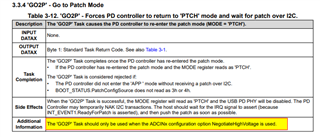I succesfully loaded patch over I2C. Now I want to reload another configuration. GO2P command fails with code 0x3 Task rejected.
Is it possible to reload I2C configuration again?
Datasheet states:
The 'GO2P' Task is considered rejected if:
• The PD controller did not enter the 'APP ' mode without receiving a patch over I2C.
• BOOT_STATUS.PatchConfigSource does not read as 3h or 4h.
6h = A configuration has been loaded from I2C.
Does this mean that I2C patch configuration CANNOT be reloaded ever again? Why?


